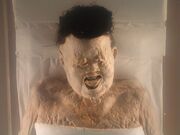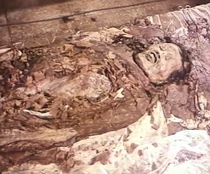Xin Zhui, also known as Lady Dai or Marquise of Dai, was the wife of Li Chang, Marquis of Dai, who lived during the Han Dynasty. She was a minor autocrat, the wife of a provincial nobleman. She was found in an unusually large coffin filled with wealthy artifacts and fine fabrics, in Mawangdui, in Changsha, Hunan Province, China. The items in the coffin indicated that she was an elite noble of great import. The tomb was discovered in 1972 during work on an air raid shelter.
Mummification[]
Xin Zhui is one of the world's best preserved mummies. Research continues as how exactly her body was body was preserved so well that her joints were flexible, the skin still elastic, the eyelashes still be intact. Her brain was only half its normal size, but completely intact.

She was found in a large tomb and was sealed inside a four-layered coffin. Her body was wrapped in 20 layers of fine silk and was submerged in an unidentified reddish liquid which contained traces of cinnabar, a mercury ore, and was mildly acidic.
Studies[]
Anthropologists still study the preservation of Xin Zhui in hopes of eventually understanding this particular method of preservation. Some inconclusive theories have been proposed in regard to the mummification, such as the well-sealed tomb preventing the entrance of new bacteria and the life of bacteria that remained inside the tomb.
A standard autopsy was conducted on December 14, 1972. Her estimated body weight while alive was 70 kilos (155 pounds) on a 4 foot 2 (128 cm) frame, suggesting she was some 50-60 pounds overweight at the time of her death.
Pathology[]

Autopsy results indicated blood clots, and evidence indicated she had died from a heart attack. Evidence of liver disease, gallstones, high cholesterol, and diabetes were also found. She carried tape worms and whip worms. Evidenced a fused disc in her lower spine and apparently she walked with a cane. It was discovered that she had died a few hours after ingesting melons.
Additional[]
The tomb of Lady Xin Zhui was buried 12 meters underground, and was very well-preserved. The body was found inside a four layered tomb, wrapped in 20 layers of silk, and 80 litres of an unknown reddish liquid, which some believe to be the reason why she was so well-preserved.
The body and tomb are considered an important archaeological discovery. Besides having some of the best-preserved human remains ever discovered in China, the contents of Xin Zhui's tomb revealed an incredible amount of information about life in the Han dynasty that was previously unknown. The discovery continues to advance the fields of archaeology and science in the 21st century, particularly in the area of preservation of ancient human remains. Scientists in 2003 developed a “secret compound” that was injected into Xin Zhui's still existing blood vessels to assure her preservation. Research at the Hunan Provincial Museum continues in an effort to perfect corpse preservation, using Xin Zhui as the main candidate for such procedures.
She had been buried with her wardrobe of 100 silk garments, 160 carved wooden figures representing her servants, as well as her makeup and toiletries.
The tomb also held the bodies of her husband and son though not so well preserved.
External Links[]
https://en.wikipedia.org/wiki/Xin_Zhui
References[]
http://www.ancient-origins.net/ancient-places-asia/enduring-mystery-lady-dai-mummy-001357
Holloway, April. (2014). The enduring mystery of the Lady of Dai mummy. Ancient Origins. <
☀http://www.ancient-origins.net/ancient-places-asia/enduring-mystery-lady-dai-mummy-001357>
